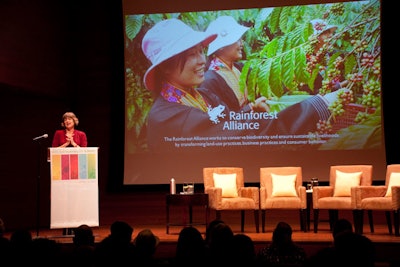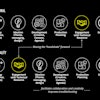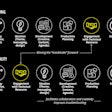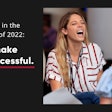
During planning for the International Special Events Society New York Metro Chapter's second Sustainability Summit, the Accepted Practices Exchange and A.S.T.M. (formerly the American Society for Testing and Materials) released their long-awaited green meetings and events standards. Chairwoman Jill Taub Drury realized the summit had to change so it would practice what it was teaching.
“There are a number of events about green that aren’t green,” Drury said. “We felt like it was important to walk the walk. I wanted people to see the experience is not missing anything.”
About 200 event professionals saw the results Tuesday at this year’s summit, held at the Rubin Museum of Art. The event, timed to fall a few weeks before Earth Day, brought green resources, tips, and trends to the industry through workshops and speakers. Its Marketplace 2.0 brought together sponsors and green experts on topics from rooftop gardens to converting cooking oil to biodiesel fuel. “We believe sustainability is not a cause but a mandate,” Drury said.
Green efforts on display Tuesday included serving a menu of at least 25 percent local, organic, or sustainable foods, which Rubin in-house caterer Stephen Starr Events was able to do. The event also partnered with composting company Royal Waste Services and required materials to be printed on recycled paper to help achieve a 45 percent waste diversion. Signage was created from recycled soft-drink bottles. Attendees could access speaker bios and sponsor information by scanning QR codes with their smartphones.
“It’s threatening, particularly if you’re a small business, for people to say you have to do this now,” Drury said, but she pointed out that all businesses have to adapt to survive, and change can start with small steps. The ISES summit was a way for people to get direction.
The event set a good example for planners by adopting the new green meetings standards, said Mitchell Beer, chairman of the Green Meeting Industry Council Foundation. “For the first time, I’m seeing how it will be rolled out,” he said. “It’s going to be incredibly powerful. This group is learning by experiencing it, and now they can learn by doing.”
Keynote speaker Tensie Whelan of the Rainforest Alliance emphasized the importance of working together for change. One catering company may not be able to pressure a supplier to shift to green practices, she said, but several companies working together might. Concerned about paying a premium for green? One tip Whelan suggested was offering a vendor a longer-term contract for more favorable pricing. Whelan also encouraged event planners and vendors to promote their green efforts. Staying under the radar, she said, “[loses] an opportunity to educate people and reinforce good behavior.”
Lee Ballin, who heads sustainability efforts at Bloomberg LP, described the company’s commitment, which includes using green practices at its 5,000 events a year. Bloomberg’s efforts include big, company-wide goals, like cutting its carbon footprint in half by 2013, and employee-level efforts, like removing everyone’s individual trash cans. Workers can either recycle their waste or take a literal guilt trip to a trash station where bins are marked “Landfill.”
Paul Neuman of Neuman’s Catering, the event’s general-session chairman, led a discussion on sustainable event planning with Ballin, Jimmy Carbone of Jimmy’s No. 43 and Food Karma Projects, and Robert LaValva of New Amsterdam Market. Neuman said he wanted to share the message that “green is good business.”



















